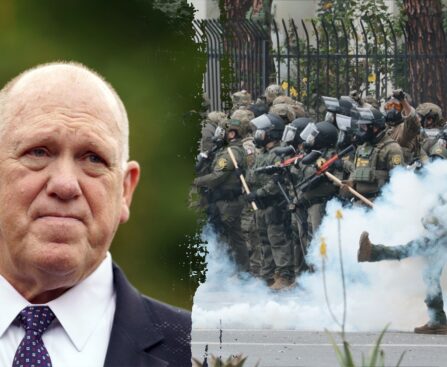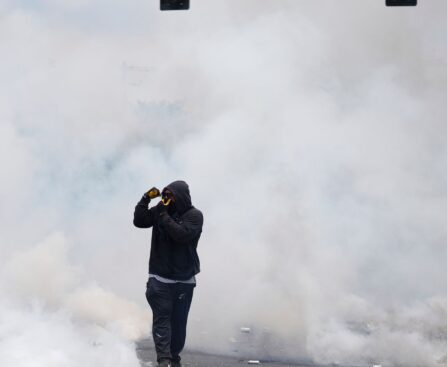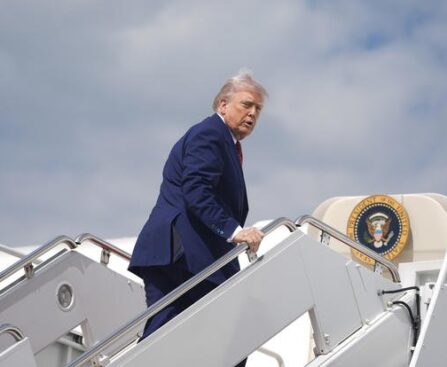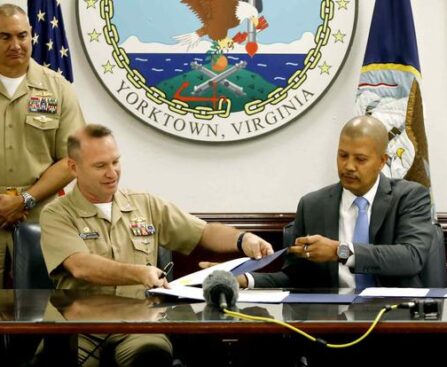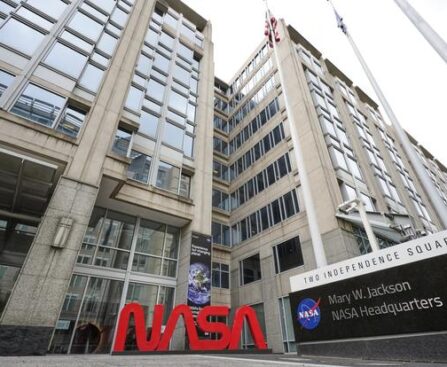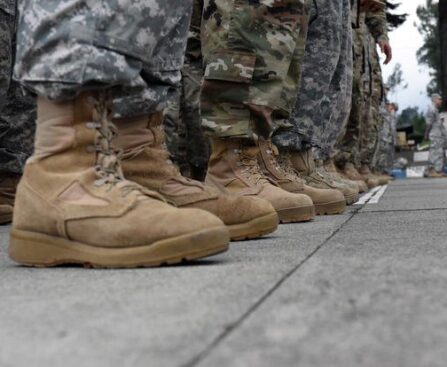NEWYou can now listen to Fox News articles! The National Guard will be deployed to Los Angeles County after anti-ICE protests continued to escalate Saturday afternoon, Trump administration border czar Tom Homan told Fox News Saturday. On Saturday, tear gas was deployed near Home Depot in Paramount, California, where ICE agents were allegedly conducting a […]
A group of protestors demonstrated against action by federal immigration authorities in Paramount, California on Saturday, June 7. The day before, on June 6, more than 40 people were arrested during Immigration and Customs Enforcement (ICE) raids, which also prompted protests.
The Los Angeles Times reported that people near a Paramount Home Depot were chanting “Fuera ICE,” or ICE, get out, and flash-bang grenades were lit, though the news outlet wrote it was not immediately clear who deployed them. Border Patrol personnel wearing riot gear and gas masks deployed tear gas at an industrial park, according to the Associated Press.
According to the Los Angeles Sheriff’s Department, law enforcement responded to a report of a “large crowd” gathering around the 6400 Block of Paramount Boulevard and “blocking traffic” around 11 a.m. PDT June 7.
In a Nixle alert, the department said it “was not involved in any federal law enforcement operations or actions and responded solely for traffic and crowd control management.” Los Angeles is a “sanctuary city,” meaning it restricts local law enforcement from working with federal immigration authorities.
U.S. Rep. Nanette D. Barragán, D-Calif., called what was happening “unacceptable.”
“ICE has brought their terror tactics and masked agents to #Paramount this morning — in my district,” she wrote on X. “We will demand answers and accountability.”
Federal law enforcement operations are proceeding “as planned this weekend in Los Angeles County,” Bill Essayli, U.S. Attorney for the Central District of California, said on X.
“I urge the public to refrain from interfering with these lawful actions,” Essayli said. “Anyone who obstructs federal agents will face arrest and prosecution.”
Homeland Security Secretary Kristi Noem took to social media to tell the protestors, “you will not stop us or slow us down.”
“@ICEgov will continue to enforce the law,” she wrote.
NEWYou can now listen to Fox News articles! President Donald Trump warned on Saturday that there would be “serious consequences” for Elon Musk if he were to fund Democratic candidates. The president made the remark during a phone interview with NBC News. “If he does, he’ll have to pay the consequences for that,” Trump told […]
Trump and Elon’s war of words Fox News host Will Cain breaks down President Donald Trump and Elon Musk’s ‘big, ugly battle’ on ‘The Will Cain Show.’ NEWYou can now listen to Fox News articles! Elon Musk appeared to jokingly reconsider his stance on the Big Beautiful Bill after a California Democrat came to his […]
NEWYou can now listen to Fox News articles! From bringing the heat to retreating on the beef. Elon Musk appears to be backtracking on some of the wild accusations he made during his ugly spat with President Donald Trump earlier this week. Musk sensationally posted on Thursday that the president’s name appears in unreleased Jeffrey […]
WASHINGTON (AP) — President Donald Trump really wants to fly on an upgraded Air Force One — but making that happen could depend on whether he’s willing to cut corners with security.As government lawyers sort out the legal arrangement for accepting a luxury jet from the Qatari royal family, another crucial conversation is unfolding about modifying the plane so it’s safe for the American president.Installing capabilities equivalent to the decades-old 747s now used as Air Force One would almost certainly consign the project to a similar fate as Boeing’s replacement initiative, which has been plagued by delays and cost overruns.
Air Force Secretary Troy Meink told lawmakers Thursday that those security modifications would cost less than $400 million but provided no details.Satisfying Trump’s desire to use the new plane before the end of his term could require leaving out some of those precautions, however.A White House official said Trump wants the Qatari jet ready as soon as possible while adhering to security standards. The official, who spoke on the condition of anonymity, did not provide details on equipment issues or the timeline.Trump has survived two assassination attempts, and Iran allegedly also plotted to kill him, so he’s well aware of the danger he faces. However, he seems willing to take some chances with security, particularly when it comes to communications. For example, he likes to keep his personal phone handy despite the threat of hacks.He boasted this week that the government got the jet “for free,” saying, “We need it as Air Force One until the other ones are done.”Here’s a look at what it would take to make the Qatari plane into a presidential transport:What makes a plane worthy of being Air Force One? Air Force One is the call sign for any plane that’s carrying the president. The first aircraft to get the designation was a propeller-powered C-54 Skymaster, which ferried Franklin D. Roosevelt to the Yalta Conference in 1945. It featured a conference room with a bulletproof window.Things are a lot more complicated these days. Boeing has spent years stripping down and rebuilding two 747s to replace the versions that have carried presidents for more than three decades. The project is slated to cost more than $5.3 billion and may not be finished before Trump leaves office.A 2021 report made public through the Freedom of Information Act outlines the unclassified requirements for the replacement 747s under construction. At the top of the list — survivability and communications.The government decided more than a decade ago that the new planes had to have four engines so they could remain airborne if one or two fail, said Deborah Lee James, who was Air Force secretary at the time. That creates a challenge because 747s are no longer manufactured, which could make spare parts harder to come by.Air Force One also has to have the highest level of classified communications, anti-jamming capabilities and external protections against foreign surveillance, so the president can securely command military forces and nuclear weapons during a national emergency. It’s an extremely sensitive and complex system, including video, voice and data transmissions.James said there are anti-missile measures and shielding against radiation or an electromagnetic pulse that could be caused by a nuclear blast.“The point is, it remains in flight no matter what,” she said.Will Trump want all the security bells and whistles? If the Qatari plane is retrofitted to presidential standards, it could cost $1.5 billion and take years, according to a U.S. official who spoke on the condition of anonymity to provide details that aren’t publicly available.Testifying before Congress this week, Meink discounted such estimates, arguing that some of the costs associated with retrofitting the Qatari plane would have been spent anyway as the Air Force moves to build the long-delayed new presidential planes, including buying aircraft for training and to have spares available if needed.In response, Rep. Joe Courtney, D-Conn., said that based on the contract costs for the planes that the Air Force is building, it would cost about $1 billion to strip down the Qatar plane, install encrypted communications, harden its defenses and make other required upgrades.James said simply redoing the wiring means “you’d have to break that whole thing wide open and almost start from scratch.”Trump, as commander in chief, could waive some of these requirements. He could decide to skip shielding systems from an electromagnetic pulse, leaving his communications more vulnerable in case of a disaster but shaving time off the project.After all, Boeing has already scaled back its original plans for the new 747s. Their range was trimmed by 1,200 nautical miles, and the ability to refuel while airborne was scrapped.Paul Eckloff, a former leader of protection details at the Secret Service, expects the president would get the final say.“The Secret Service’s job is to plan for and mitigate risk,” he said. “It can never eliminate it.”If Trump does waive some requirements, James said that should be kept under wraps because “you don’t want to advertise to your potential adversaries what the vulnerabilities of this new aircraft might be.”It’s unlikely that Trump will want to skimp on the plane’s appearance. He keeps a model of a new Air Force One in the Oval Office, complete with a darker color scheme that echoes his personal jet instead of the light blue design that’s been used for decades.What happens next? Trump toured the Qatari plane in February when it was parked at an airport near Mar-a-Lago, his Florida resort. Air Force chief of staff Gen. David Allvin was there, too.The U.S. official said the jet needs maintenance but not more than what would be expected of a four-engine plane of its complexity.Sen. Tammy Duckworth, an Illinois Democrat on the Senate Armed Services Committee, said it would be irresponsible to put the president and national security equipment aboard the Qatari plane “without knowing that the aircraft is fully capable of withstanding a nuclear attack.”“It’s a waste of taxpayer dollars,” she said.Meanwhile, Boeing’s project has been hampered by stress corrosion cracks on the planes and excessive noise in the cabins from the decompression system, among other issues that have delayed delivery, according to a Government Accountability Office report released last year.Boeing referred questions to the Air Force, which said in a statement that it’s working with the aircraft manufacturer to find ways to accelerate the delivery of at least one of the 747s.Even so, the aircraft will have to be tested and flown in real-world conditions to ensure no other issues.James said it remains to be seen how Trump would handle any of those challenges.“The normal course of business would say there could be delays in certifications,” she said. “But things seem to get waived these days when the president wants it.”___AP writer Lolita C. Baldor in Washington contributed to this report.
Story Continues
© Copyright 2025 Associated Press. All rights reserved. This material may not be published, broadcast, rewritten or redistributed.
YORKTOWN — Leadership of Naval Weapons Station Yorktown and Dominion Energy have signed an agreement to work together to build energy resiliency at the station.Potential projects at the weapons station could include solar farms, turbine energy or a small modular nuclear reactor.Cpt. Dan Patrick said it has been a goal of his to have more sustainable power sources for the station. Over the next decade, power demand in Virginia is going to increase, so having a diverse source of power is necessary for the station to continue providing weapons support to other military installations across the East Coast, he said. Dominion has forecasted a 5.5% annual demand increase over the next decade and double by 2039.Dominion Energy and the installation have worked for about 18 months ahead of Friday’s agreement signing to see how a project at NWS Yorktown could fit into long-term energy plans. The first step is a site characterization study, which will determine where and what kind of project would work best in the area. Those typically take six to 12 months, according to Dominion officials.Patrick pointed to a historic long-term power outage in Tacoma, Washington as evidence of his concerns. In 1929, the city of Tacoma generated much of its electricity by hydroelectric dams on nearby rivers, but after a drought, the city struggled to provide enough power to keep citizens warm that winter. Fort Lewis, an Army base located located 9.1 miles south-southwest of Tacoma, had its barracks go “lights out” at 4 p.m. to help conserve power. Then-President Herbert Hoover sent the Navy’s USS Lexington to power the city for about a month.“If we don’t take the necessary steps to build reliant and resilient energy sources for the installation community, we clearly become very vulnerable,” he said. “As our country reaffirmed its commitment to energy dominance, it becomes ever clear that what we do with electricity and energy over the next five years will determine our installation’s readiness for the next 50.”Ed Baine, president of Dominion Energy Virginia, said whichever method is selected would be owned and operated by Dominion. If a nuclear reactor is chosen, he is confident in the company’s ability to handle nuclear facilities safely.Baine said short-term energy sources for the company to meet growing demand will be gas and renewable energy, but long-term plans for the company will have to include small reactors. In October, the power provider announced a partnership with Amazon to develop a small modular reactor as the utility explores building one at its North Anna Power Station, an existing traditional nuclear power plant in Louisa County. A small reactor is about a third of the size of the Surry Nuclear Power Plant, which is located just across the James River from the weapons station. On June 3, the York County Board of Supervisors approved a resolution to sponsor a study that would look at potential zoning ordinances regarding small nuclear reactors. Currently, the county’s code does not address reactors at all.Baine and Patrick said whatever power source is chosen, it will bring benefits on a regional scale.“Our overall goal and intent is that if something were to happen elsewhere, the base and the community — our major workforce — would have the lights and power on so we can continue without having to worry about the families at home or the local community not being able to work with us,” Patrick said.©2025 The Virginian-Pilot. Visit pilotonline.com. Distributed by Tribune Content Agency, LLC.
Story Continues
© Copyright 2025 The Virginian-Pilot. All rights reserved. This material may not be published, broadcast, rewritten or redistributed.
Thousands of veterans gathered and raised their fists to the rhythm of the punk rock band Dropkick Murphys on Washington, D.C.’s National Mall on Friday, rallying against the Trump administration’s federal job cuts and the potential loss of government services.Many attendees of the Unite for Veterans, Unite for America Rally carried signs, including some that read “I Stand With Vets;” “Respect, Honor, Pay, Veterans;” and “VA Support Isn’t a Gift, It’s a Debt.” The protest rally, part of the growing public concern over the administration’s plans to dramatically reshape the federal government, also coincided with the 81st anniversary of D-Day.Since President Donald Trump took office, layoffs from government jobs have affected veterans who make up a large percentage of the federal workforce, with some congressional estimates that around 6,000 former service members have lost their livelihoods. An internal memo obtained by Military.com in March showed that more than 80,000 Department of Veterans Affairs employees could be fired, which advocates say would harm important services.Read Next: White House Asked Joint Chiefs Chairman for Candidates to Lead NASA, Worrying ExpertsLead singer of the Dropkick Murphys Ken Casey said it in his own way, telling the veterans in the crowd that he supported them before tearing into newly released music. Veterans in attendance associated the band with their service during the Global War on Terror.”We have always stood with the vets, and the vets have always stood with the Dropkick Murphys,” Casey said. “When sh– ain’t right, we’re going to speak up. That’s what it’s all about and guess what? Sh– ain’t right!”
Former Army Sgt. Will Attig, who recalls being an 18-year-old riding in a Humvee and listening to Dropkick Murphys music during his deployment to Iraq, said it was a surreal moment to be standing on a stage next to Casey.”There’s a connection with music,” said Attig, who was one of the organizers of the event. “Music is a part of the veterans community. … Music is one of the ways we fight back.”The protest brought together veterans advocacy groups and service members from different generations like Randall Goldberg, a former Army soldier who said he left the service in 1970 and is angered by the Trump administration’s actions when it comes to veterans.”There has to be resistance to those folks,” Goldberg said of the loss of federal jobs and projected cuts. “It’s nuts; it’s nothing fair.”In addition to numerous generations of veterans in attendance, vocal veterans in Congress also spoke and made appearances at the event.Sen. Ruben Gallego, an Arizona Democrat and a Marine Corps veteran, told Military.com in an interview on the National Mall that the potential cuts to the Department of Veterans Affairs have pushed many former service members to speak out.”We just tend to suck it up, right?” Gallego said of the veteran community. “I think this has pushed a lot of veterans to an existential moment, because we’ve never seen something like this.”Sen. Tammy Duckworth, an Illinois Democrat and retired Army National Guard lieutenant colonel who was wounded in combat, rallied the crowd as one of the scheduled speakers.She spoke out about many of Trump’s policies and the so-called “One Big, Beautiful Bill,” legislation working through Congress to enact Trump’s agenda that she described as “a middle finger to our heroes” by offering tax cuts instead of keeping jobs.The crowd, in response, raised their own middle fingers to the sky.”You deserve better; you’ve earned better,” Duckworth said during her remarks. “Since our warriors landed on the beaches of Normandy on this very day 81 years ago, those who have worn the uniform have defied the odds to define America at her best. America is what she is today because of the blood of brothers and sisters shed in combat zones.”Dropkick Murphys played many of their signature hits, including “I’m Shipping Up to Boston” and “Rose Tattoo,” but it was a newly released song played by the band titled “Who’ll Stand With Us?” that appeared to strike the biggest chord.”Who’ll stand with us? Don’t tell us everything is fine, Who’ll stand with us? Because this treatment is a crime,” Casey belted to the crowd, with many attendees nodding in agreement.Related: Dropkick Murphys, Lawmakers to Join Veterans in Washington on D-Day to Protect VA Benefits, Federal Jobs
Story Continues
The White House made the unusual move of reaching out Gen. Dan Caine, the chairman of the Joint Chiefs of Staff, for advice on who should serve as the next NASA administrator, causing experts to worry about military influence on the civilian space agency.At a news conference Thursday, President Donald Trump said that “Gen. Caine is going to be picking somebody” for the top role in NASA, which is separate from the Defense Department, and that somebody “will be checking them out.” It was unclear who Trump was referring to in regards to checking candidates, or if any other military officials were consulted.On Friday, a White House official went further, telling Military.com that Trump reached out to Caine because he “wants to ensure his next nominee is aligned with his America First vision, and shares his desire to help lead humanity into space and plant the American flag on the planet Mars.”Read Next: Army Ends Most Barracks Maintenance at Fort Cavazos Amid Federal CutsThe revelation that Caine was asked for recommendations about the next head of NASA — a civilian agency with a peaceful mission — is unusual and, according to experts, an alarming signal that the Trump administration may be looking to blur the concept of scientific space exploration with the growing arms race and military interests in space.Furthermore, the White House statement also serves to further politicize Caine and the otherwise apolitical position of the military by suggesting that the four-star general would be a good arbiter of who can carry out Trump’s political “America First” agenda.
Caine himself was an unusual pick by Trump that raised eyebrows because he had retired from military service and did not meet the statutory requirements for being the Joint Chiefs chairman, requiring a presidential waiver.Meanwhile, outside experts on the space agency were baffled and concerned by the move.”The [chairman of the Joint Chiefs of Staff] has no interaction or reporting relationship with the NASA administrator,” said Todd Harrison, a senior fellow at the American Enterprise Institute and an expert on defense policy. “And as far as I know, he has no space exploration expertise to contribute.”Caine, who retired as a lieutenant general, was an F-16 Fighting Falcon pilot and held numerous National Guard assignments throughout a three-decade career. Before retiring, he served as the associate director for military affairs at the CIA.Grace Bartlinski, a NASA spokesperson, told Military.com that the agency “does not choose its own administrator or dictate the process by which one is chosen” and deferred comment to the White House.One of Trump’s proudest achievements from his first term was signing the National Defense Authorization Act in 2019 that created the Space Force, a point he makes known often in public forums. However, despite its name, the Space Force doesn’t send troops into space. Instead, it is largely tasked with defending the U.S. from threats from outside the atmosphere.Though the Department of Defense and NASA do have a relationship, including the services loaning troops as astronauts, they have vastly different missions, with NASA’s mandate being focused squarely on scientific exploration and manned spaceflight.The distinction goes back decades, and NASA’s peaceful mission allowed it to be one of the few areas of cooperation between the U.S. and the Soviet Union during the Cold War. In 1975, less than three years after the last American walked on the moon, NASA carried out the first joint mission with the Soviets known as Apollo-Soyuz.That cooperation would then grow to the first U.S. astronaut living aboard the Russian space station Mir, a precursor to today’s International Space Station, in the early months of 1995. After the U.S. retired the space shuttle in 2011, NASA astronauts relied on the Russian Soyuz spacecraft to get into space.Any appearance of the Trump administration blurring those lines — such as leaning on the military to pick a NASA leader — is concerning to space experts.Victoria Samson, the chief director of space security and stability at the nonprofit Secure World Foundation, said she didn’t “know why you would have a military officer talking about who would be best placed to be in charge of a civil space agency.””I mean, there’s separation of church and state between military space and civil space, that’s pretty clear, right? And that’s the whole point,” Samson added.Trump first named Jared Isaacman, a billionaire business executive and commercial astronaut, as his nominee to lead NASA, but withdrew his nomination late last month after a “thorough review of prior associations,” the president said on social media.Isaacman would go on to tell The All In podcast that he thought he lost out on the job because of his ties with Elon Musk, who also recently left the Trump administration, saying that there wasn’t “much of a coincidence” between the departure and his name being pulled from consideration.One name reported as a potential choice to replace Isaacman is retired Air Force Lt. Gen. Steven Kwast, Reuters reported. His last role was as head of Air Education and Training Command at Joint Base San Antonio-Randolph in Texas. He was, notably, a fierce advocate of creating the Space Force.Caine did not respond to a query from Military.com on whether he recommended Kwast.Related: Trump Names Space Force Vice Chief to Oversee Golden Dome Missile Defense Project
Story Continues
The deadline for transgender service members on active duty to voluntarily leave the military arrived Friday, setting the stage for the Pentagon to soon begin kicking out those troops.For the transgender service members faced with the decision to leave or be booted later, Friday — which also marks the first full weekend of Pride Month when many cities around the country, including Washington, D.C., will be holding parades and festivals celebrating LGBTQ+ rights — was an agonizing day.One of the service members who has decided to leave is Maj. Erica Vandal, a West Point graduate and field artillery officer who was raised in a military family. While Vandal said she “absolutely” wants to continue serving, she had to consider her ability to support her wife and their two children.Read Next: Army Ends Most Barracks Maintenance at Fort Cavazos Amid Federal Cuts”Honestly, I feel a lot of guilt regarding my decision,” Vandal said in a phone interview Friday. “I have no doubt that is what is best for me and my family, just in our circumstances right now. It is the best decision when weighed against this carrot-and-stick policy that we are currently up against. That being said, I have that kind of guilt that I’m almost taking a step back from this fight contrary to how I was raised by my father and everything that the Army has taught me over the past 14 years.”Friday’s deadline for active-duty troops was set in a May memo the Pentagon issued after a Supreme Court ruling allowed the department to enforce a ban on transgender troops while lawsuits against the ban are still under consideration by lower courts.
Transgender members of the reserve and National Guard have until July 7 to voluntarily separate.The Pentagon had originally set a March deadline for transgender troops to voluntarily leave, but that deadline was forestalled by court rulings before the Supreme Court stepped in.The department previously said about 1,000 troops requested to voluntarily separate in March, though it has declined to provide a more specific number.The Pentagon’s latest ban on transgender troops is the result of an executive order President Donald Trump signed during his second week in office in January that contended being transgender is “not consistent with the humility and selflessness required of a service member.”Under the policy the Pentagon issued in February to implement Trump’s order and reaffirmed in the May memo, troops with a history of gender dysphoria, who “exhibit symptoms” of gender dysphoria, or who have transitioned to their gender identity are now disqualified from service.Defense officials said in May they will rely on annual health screenings and recommendations from commanders in identifying troops to kick out.But before that, the department has been trying to entice transgender troops to leave of their own accord by offering financial incentives.The service members who elected voluntary separation by Friday are eligible for twice the amount of separation pay they would get if they are later involuntarily discharged from the military.Involuntary separation pay is typically 10% of a service member’s annual base pay multiplied by their years of service. Many transgender troops have been serving for a decade or more, so doubled separation pay could easily top $300,000.The Navy also said this week that it was expanding eligibility for early retirement for transgender troops who voluntarily separate. Under the new criteria, transgender sailors with at least 15 years of service can request early retirement, unlocking significantly more benefits than they would otherwise get for leaving with fewer than 20 years of service.The Air Force and Army are also allowing transgender troops with at least 15 years of service to request early retirement if they voluntarily separate.Despite wanting to continue to serve, the separation pay and stability of leaving on her own terms swayed Vandal’s decision.”If I was only worried about myself, there’s not a doubt in my mind that I would be fighting this tooth and nail, that this would be the hill I would plant my flag on and would die on if necessary,” Vandal said. “However, with the family considerations, I think it drastically changes the kind of math involved with that.”The transgender ban is being challenged by two lawsuits, meaning it could still be blocked by the courts in the coming months.Vandal is a plaintiff in one of the lawsuits and, despite separating, plans to stay a plaintiff with hopes of one day being reinstated.”This voluntary separation was a coerced separation, voluntary in name only,” she said. “Even after everything, I love this country, I love the Army, I love the military, and I’m proud of my service and would like to continue to serve.”The lawsuits have slowed down considerably since the Supreme Court ruling.The Ninth Circuit Court of Appeals, which is weighing one of the lawsuit’s requests for an injunction against the policy, issued a notice this week saying oral arguments about the injunction could be held in October.The D.C. Circuit Court of Appeals, which is weighing the other lawsuit’s injunction request, has given no indication of when it might issue a decision since it heard oral arguments in April.Shannon Minter, legal director of the National Center for Lesbian Rights and one of the lawyers for the plaintiffs in the D.C. lawsuit, said the delay since the April arguments is unusually long but speculated the D.C. Circuit is overwhelmed with challenges to Trump administration policies.Whatever the appeals court decides on the injunction, and even as the ban begins to be implemented, Minter vowed to keep fighting.”The government itself does not claim — I mean, they couldn’t. There would be nothing to support this — but they don’t claim that any of these service members have done anything wrong. They’re simply kicking them out because they’re transgender,” Minter said. “One hundred percent we’re not going to stop fighting.”Related: Pentagon Will Use Health Screenings, Commanders to Ferret Out Trans Troops for Separations
Story Continues

